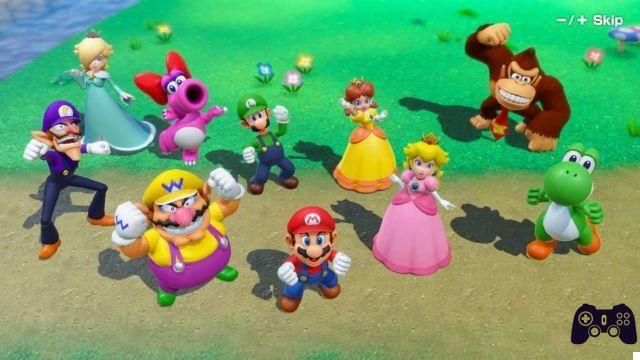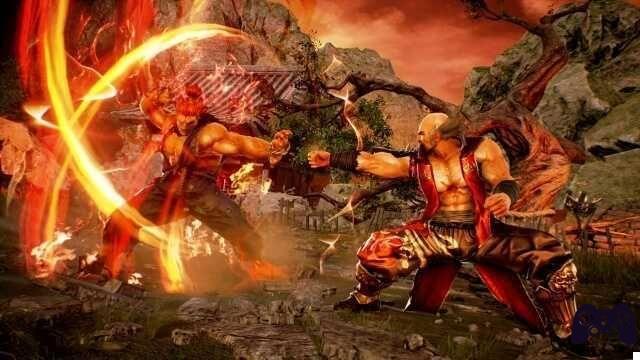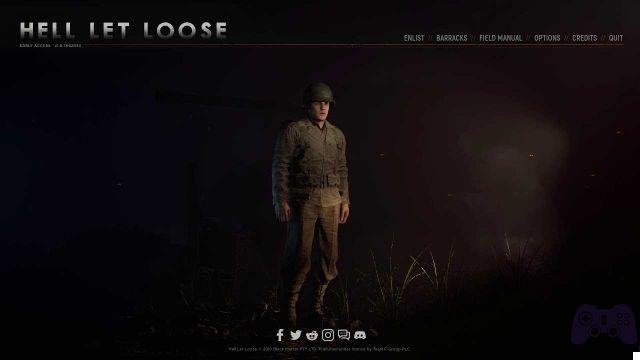Ark Survival Evolved is not a simple game and starting on the wrong foot can make the experience even more complicated: here are some tips for those who need to start
If Ark intrigues you but you are afraid of not knowing how to deal with such a massive and elaborate game, here is for you a guide to the initial stages: we will discover the best spawn point, so as to create a nice safe base, and we will try to understand what our first goals should be.
NB All articles on Ark, unless otherwise specified, refer to The Island map.
The best spawn point
As you surely know (you have read our review, right?) In Ark we do not have a single starting point: the game, from the first spawn, allows us to choose one place among many to start from. We will always be on a beach, but it will be up to us to choose which one.
The game helps us by giving us an idea of the difficulty level of each spawn point: in general the south is a correct starting point for all the inexperienced. However, there are three areas that the game defines as "south": these are simply numbered as "South Zone 1", "South Zone 2" and "South Zone 3". Let's see it on the game's respawn map.
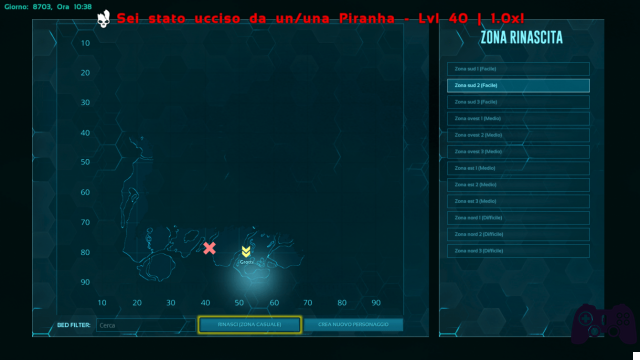
We'll talk about the Piranhas soon, I promise.
“South Zone 1” is roughly where the red cross is (which represents where I died). The "South Zone 2" is what you can see illuminated at the coordinates Lat. 85, Long. 55. The “South Zone 3”, on the other hand, is further to the right, but we are not interested.
My personal choice as "best spawn point" is the zone at the coordinates Lat.82, Long.47. Lat. plus, Long. less, of course. To help you, I show you the location through the game map.
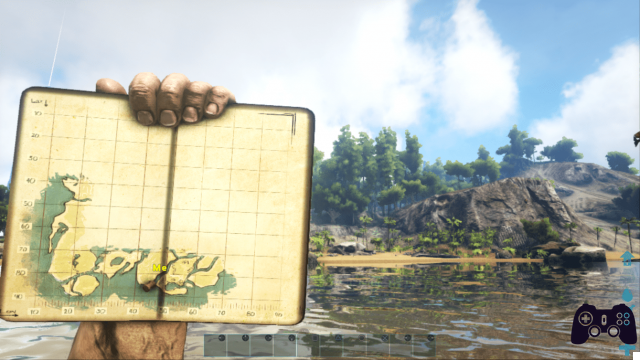
Yes, the in-game map isn't very accurate, but we have to make do with it.
In this image you can see the position on the game map and in the background the beach which I think is an excellent place to start. In addition to satisfying all the basic initial needs such as proximity to water, a large, sufficiently flat clearing, the presence of basic resources in the immediate vicinity such as trees, rocks and bushes, this area is protected, as you can see, by a small promontory. It might seem like a minor feature, but having a covered side is a help that shouldn't be turned down, especially when deciding to create a protective wall.
All the resources needed for the more advanced stages
Also, nearby (to the northwest) there are many units of metal-rich rocks, the fundamental material for the evolution of our caveman. To this is also added one cave within walking distance from our beach: at the entrance, it will allow us to safely collect large quantities of crystal, while deeper, but well defended, we will have obsidian and more metal, as well as some tameable pets that might be useful later on. Finally, there are various petroleum rocks, in the sea to the south, which are not too far away (nor too deep, which is what matters most) and can be reached with any aquatic mount without fear.
A couple of problems not to be underestimated
To reach this area the best choice is to start from "South Zone 2". Unfortunately there is a problem: the game does not have a single spawn point within the "Zones". Each game will be defined randomly, so we can find ourselves more or less distant. We will have to walk the beaches as quickly as possible to avoid violent deaths. Of course, we will have to cross a stream. You might think that a stream a few meters wide does not involve great difficulties: you would be wrong. In the early stages, the game's biggest enemy is the (cursed) Piranha. The sneaky freshwater predator is fast, powerful, and never alone. Obviously after a short time it will no longer represent a threat, but in the very early stages you will have to calculate your moves well.
The countermeasures are clear: choose the narrowest point, use your skills as a primitive runner to perform some parkour on the rocks that often peek into rivers and hope not to become fish food. Alternatively, it is possible to devote oneself to the ancient technique of fishing (funny but involuntary linguistic coincidence, I swear): that is to attract the piranhas by entering the water, launch in the hand, then retreat to the shore and hit them before their return to deeper waters. It is a slow but safer practice, especially useful if the spawn point is far away.
Once you arrive at your destination
Once on the right beach, we will have to aim to create a small safe area and a bed for respawn. Before we can make a bed, we will have a sleeping bag available. The fundamental difference is that the sleeping bag is disposable and can be placed directly on the ground - as well as being collected and replaced - while the bed requires building foundations and can be used indefinitely, requiring only a recharge time. between one respawn and another.
Therefore, creating a sleeping bag is a very subjective choice that depends on how safe you feel in the chosen area. Being in the south and in the very first days of the island, it is very difficult to come across insurmountable threats, but some Raptors can always crop up. Any carnivore larger than a Dilophosaurus is absolutely out of our reach, especially if we are alone, so we will have to avoid it and, if it has placed itself in the area designated by us, we will have to hope that it goes away, observing it from afar. The sleeping bag can be useful to avoid having to travel great distances in the event of death, but it must be recreated every time and the skin, in the initial stages, is a resource not to be wasted.
If we feel confident that we can survive the time it takes to level and learn how to make a bed, let's keep our skin and start making a small thatched hut. The only truly essential element are the foundations, on which we can rest the bed, but having walls and a roof is not bad at all. A complete building will not only prevent dinosaurs from sitting on our bed, it will also protect us from excessive heat and cold.
Other key elements for the camp are the campfire and some boxes. The fire will create heat and cook raw meat and raw fish. The boxes are instead essential to keep all the assets that we cannot carry in our inventory. Our transport capacity, in fact, will be low and a little wood and stone accumulated will block us on the ground. Furthermore, the boxes are a lifesaver in case of death. Now we have our bed, of course, but dying always means respawning with a new body: all our objects will always be in the previous body, easily found thanks to a column of green light that will illuminate it. We can recover our previous inventory, but we will not have the skills or the will in every situation: having some boxes with basic materials (straw, wood, leather, fiber, flint) will allow us to recreate the equipment without difficulty.
The objectives to be set after the initial phases in Ark
Once these first problems have been overcome, we will have to start thinking about how to continue. Advancement in Ark is deeply tied to our ability to craft new items. You must therefore level up by gathering resources, fighting with small dinosaurs and building. A few steps north-west of the area that I have shown you (or going up the hill) you can find a note from the explorers: its recovery will give us a large amount of experience useful to speed up our evolution.
One of the next steps will also be tame some dinosaurs. Parasaurs are excellent means of transport: we will be able to load them with materials and ride them with a saddle. Dilophosaurs can make excellent bodyguards, especially in groups, and are easy to catch. For a basic guide to taming please refer to this article.
Another step in Ark is related to cultivation, outdoors or in a greenhouse.
A great way to explore, especially over long distances, will be with the raft: it is fast and keeps us safe, at least as long as we remain in the immediate vicinity of the beaches. Venturing into deep water means sinking very quickly from creatures you won't even want to see with binoculars for a long time. The real advantage of the raft is related to the possibility of building on it. Box fundamentals (or better still cabinets, which can hold multiple materials), but creating a cabin with a bed and campfire isn't bad at all. In fact, it can happen to die far from our base and be forced to respawn at great distances from the raft, also running the risk of losing orientation and no longer knowing where our aquatic vehicle is. A bed solves every problem and creates a mobile camp that will accompany us in our explorations.
Thinking about the long term, you will have to find places where you can create new bases to explore new regions of the island of Ark, but this is a topic that we will talk about in an upcoming guide.




